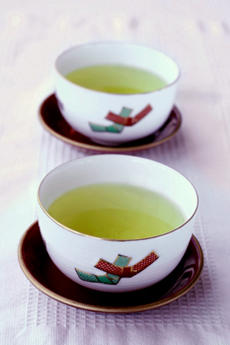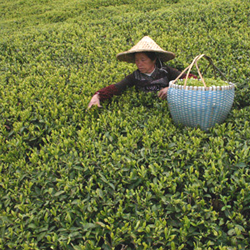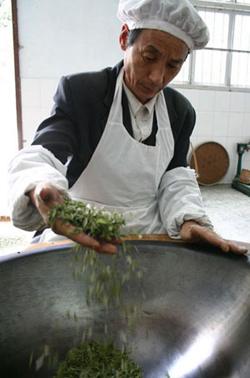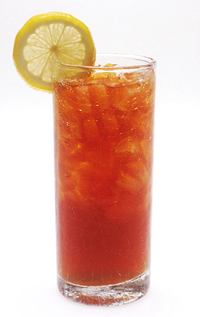

Like black tea, green tea comes in many varieties. The finest teas—generally not those poured at sushi bars—are exquisitely complex and delicate. Photo by Yoko Bates | IST.
|
 |

Gourmet Tea
Fine Teas For Everyday & Gifts
Jump To Table of Contents
Overview
Sales of gourmet tea are growing in leaps and bounds. While many Americans are discovering fine tea for the first time, tea is the world’s most popular beverage after water.* It has been cultivated in China since prehistoric times, where it is still grown in family plots. It was probably first used as a vegetable relish (as it was in American colonies and still is in some parts of Asia) and as a medicine. By the 8th century, cultivation had begun on a commercial scale, and shortly thereafter, tea cultivation began in Japan. Tea was first imported into Europe by the Dutch East India Company in the early 17th century and became an instant hit. Its popularity played an important role in the opening of Asia to Western commerce.
| |
* |
In the United States, tea is fifth in popularity, following water, coffee, soft drinks, and juice. Eighty percent of tea sold is bottled iced tea, however: Of the remaining 20%, supermarket-quality tea bags take the lions’s share. Sales of gourmet tea are still quite small. |
- All tea comes from the Camellia sinensis plant, a warm-weather evergreen (with one slight exception: In the Assam region of northeast India, the local variation, Camellia assamica was found to produce finer tea in that environment). Whether tea is black, oolong, green or white depends on how the fresh leaves of the tea plant are processed after they are plucked, and their level of contact with oxygen. During oxidation, the tea leaves undergo natural chemical reactions that result in distinctive color and taste characteristics. Black tea is allowed to oxidize for two to four hours. Green tea is not oxidized at all—the leaves are steamed, rolled and dried. Oolong tea falls somewhere between green and black teas, in that the leaves are only partially oxidized. White tea is not oxidized at all, and in fact, is plucked in the spring before the leaf buds even unfurl.
- Herbal teas do not come from the tea plant Camellia sinensis, but are an infusion of various leaves, roots, bark, seeds or flowers of other plants. While they lack the caffeine of tea, they also are not associated with any of the potential health benefits of traditional teas.
- Tea is grown in thousands of tea gardens or estates around the world. As with wine grapes, coffee and cacao beans, local soil and climate result in corresponding flavorful variations. As with coffee, each tea takes its name from the area in which it’s grown, and the areas in turn are known for their distinctive and uniquely flavored teas. Tea is also divided by grades, determined by leaf size. Smaller sized leaves are used in tea bags while the larger sized leaves can be found in packaged loose tea.
|
|

A tea picker pulling off the “two leaves and a bud.” Photo courtesy Rishi Tea. |
- While China is the world’s largest tea-producing nation, it keeps most of what it grows for its own consumption. The second largest consuming nation, India, is the largest exporter, followed by Sri Lanka, Kenya, Indonesia, Japan and Taiwan. The largest importing nations are the United Kingdom, Australia, Canada, Russia, the United States and The Netherlands.
- As with all foods, you can buy the commonplace, the sublime, or something in-between. If you love a good cup of tea—or a tall frosty glass of iced tea—you’ll appreciate the difference between fine, gourmet tea made from top quality whole leaves and mass-marketed teas produced from bits and pieces. There is such a large variety of gourmet tea, so much to discover, and so many lovely tea sets, that you can treat yourself and those on your gift list to a seemingly endless variety of black, oolong, green and white teas.
NIBBLE TIP: Don’t toss the leftover tea in the pot—pour it into ice cube trays. Tea ice cubes won’t dilute your iced tea. (Our favorite ice cube tray is the ISI Orka Ice Cube Tray—read our review to see why.) |
|

Getting ready to pan the tea leaves: lightly for green tea, more extensively for black tea. Photo courtesy Rishi Tea. |
| Articles About Tea |
Reviews ~ Gourmet Hot Tea |
|
|
|
| Reviews ~ Ready To Drink (Bottled) Tea |
|
Nibble Tip
It takes just minutes to brew at home the same gourmet iced teas you enjoy at restaurants and cafés. The assorted teas that you use for hot tea—green, blackberry, herbal—make delicious iced teas too (and using them up faster keeps your tea supply fresher). Or, buy bags or loose tea in favorite iced flavors like raspberry and peach. Enjoy experimenting to see what you like best “on the rocks,” with and without lemon or lime wedges. These delicious cold beverages are also a treat for your guests. And, they’re calorie-free!
Photo courtesy of GeekPhilosopher.com. |
|
©Copyright 2005-

|







